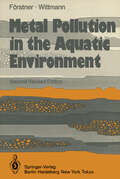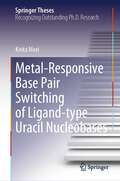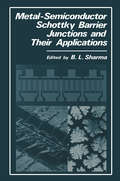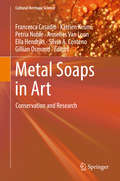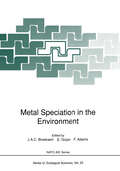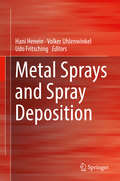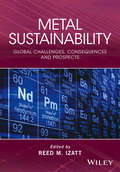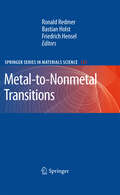- Table View
- List View
Metal Oxide Nanoparticles in Organic Solvents: Synthesis, Formation, Assembly and Application (Engineering Materials and Processes)
by Markus Niederberger Nicola PinnaMetal Oxide Nanoparticles in Organic Solvents discusses recent advances in the chemistry involved for the controlled synthesis and assembly of metal oxide nanoparticles, the characterizations required by such nanoobjects, and their size and shape depending properties. In the last few years, a valuable alternative to the well-known aqueous sol-gel processes was developed in the form of nonaqueous solution routes. Metal Oxide Nanoparticles in Organic Solvents reviews and compares surfactant- and solvent-controlled routes, as well as providing an overview of techniques for the characterization of metal oxide nanoparticles, crystallization pathways, the physical properties of metal oxide nanoparticles, their applications in diverse fields of technology, and their assembly into larger nano- and mesostructures. Researchers and postgraduates in the fields of nanomaterials and sol-gel chemistry will appreciate this book’s informative approach to chemical formation mechanisms in relation to metal oxides.
Metal Oxide Nanostructures as Gas Sensing Devices
by G. ErannaMetal Oxide Nanostructures as Gas Sensing Devices explores the development of an integrated micro gas sensor that is based on advanced metal oxide nanostructures and is compatible with modern semiconductor fabrication technology. This sensor can then be used to create a compact, low-power, handheld device for analyzing air ambience.The book first c
Metal Oxide Nanostructures Chemistry: Synthesis from Aqueous Solutions
by Jean-Pierre JolivetThis much-anticipated new edition of Jolivet's work builds on the edition published in 2000. It is entirely updated, restructured and increased in content. The book focuses on the formation by techniques of green chemistry of oxide nanoparticles having a technological interest. Jolivet introduces the most recent concepts and modelings such as dynamics of particle growth, ordered aggregation, ionic and electronic interfacial transfers. A general view of the metal hydroxides, oxy-hydroxides and oxides through the periodic table is given, highlighting the influence of the synthesis conditions on crystalline structure, size and morphology of nanoparticles. The formation of aluminum, iron, titanium, manganese and zirconium oxides are specifically studied. These nanomaterials have a special interest in many technological fields such as ceramic powders, catalysis and photocatalysis, colored pigments, polymers, cosmetics and also in some biological or environmental phenomena.
Metal Oxide Semiconductors: Synthesis, Properties, and Devices
by Zhigang Zang Wensi Cai Yong ZhouMetal Oxide Semiconductors Up-to-date resource highlighting highlights emerging applications of metal oxide semiconductors in various areas and current challenges and directions in commercialization Metal Oxide Semiconductors provides a current understanding of oxide semiconductors, covering fundamentals, synthesizing methods, and applications in diodes, thin-film transistors, gas sensors, solar cells, and more. The text presents state-of-the-art information along with fundamental prerequisites for understanding and discusses the current challenges in pursuing commercialization and future directions of this field. Despite rapid advancements in the materials science and device physics of oxide semiconductors over the past decade, the understanding of science and technology in this field remains incomplete due to its relatively short research history; this book aims to bridge the gap between the rapidly advancing research progress in this field and the demand for relevant materials and devices by researchers, engineers, and students. Written by three highly qualified authors, Metal Oxide Semiconductors discusses sample topics such as: Fabrication techniques and principles, covering vacuum-based methods, including sputtering, atomic layer deposition and evaporation, and solution-based methods Fundamentals, progresses, and potentials of p–n heterojunction diodes, Schottky diodes, metal-insulator-semiconductor diodes, and self-switching diodes Applications in thin-film transistors, detailing the current progresses and challenges towards commercialization for n-type TFTs, p-type TFTs, and circuits Detailed discussions on the working mechanisms and representative devices of oxide-based gas sensors, pressure sensors, and PH sensors Applications in optoelectronics, both in solar cells and ultraviolet photodetectors, covering their parameters, materials, and performance Memory applications, including resistive random-access memory, transistor-structured memory devices, transistor-structured artificial synapse, and optical memory transistors A comprehensive monograph covering all aspects of oxide semiconductors, Metal Oxide Semiconductors is an essential resource for materials scientists, electronics engineers, semiconductor physicists, and professionals in the semiconductor and sensor industries who wish to understand all modern developments that have been made in the field.
Metal Oxide Semiconductors: Synthesis, Properties, and Devices
by Zhigang Zang Wensi Cai Yong ZhouMetal Oxide Semiconductors Up-to-date resource highlighting highlights emerging applications of metal oxide semiconductors in various areas and current challenges and directions in commercialization Metal Oxide Semiconductors provides a current understanding of oxide semiconductors, covering fundamentals, synthesizing methods, and applications in diodes, thin-film transistors, gas sensors, solar cells, and more. The text presents state-of-the-art information along with fundamental prerequisites for understanding and discusses the current challenges in pursuing commercialization and future directions of this field. Despite rapid advancements in the materials science and device physics of oxide semiconductors over the past decade, the understanding of science and technology in this field remains incomplete due to its relatively short research history; this book aims to bridge the gap between the rapidly advancing research progress in this field and the demand for relevant materials and devices by researchers, engineers, and students. Written by three highly qualified authors, Metal Oxide Semiconductors discusses sample topics such as: Fabrication techniques and principles, covering vacuum-based methods, including sputtering, atomic layer deposition and evaporation, and solution-based methods Fundamentals, progresses, and potentials of p–n heterojunction diodes, Schottky diodes, metal-insulator-semiconductor diodes, and self-switching diodes Applications in thin-film transistors, detailing the current progresses and challenges towards commercialization for n-type TFTs, p-type TFTs, and circuits Detailed discussions on the working mechanisms and representative devices of oxide-based gas sensors, pressure sensors, and PH sensors Applications in optoelectronics, both in solar cells and ultraviolet photodetectors, covering their parameters, materials, and performance Memory applications, including resistive random-access memory, transistor-structured memory devices, transistor-structured artificial synapse, and optical memory transistors A comprehensive monograph covering all aspects of oxide semiconductors, Metal Oxide Semiconductors is an essential resource for materials scientists, electronics engineers, semiconductor physicists, and professionals in the semiconductor and sensor industries who wish to understand all modern developments that have been made in the field.
Metal Oxides/Chalcogenides and Composites: Emerging Materials for Electrochemical Water Splitting (SpringerBriefs in Materials)
by Aneeya Kumar Samantara Satyajit RathaThis book covers the recent development of metal oxides, hydroxides and their carbon composites for electrochemical oxidation of water in the production of hydrogen and oxygen as fuels. It includes a detailed discussion on synthesis methodologies for the metal oxides/hydroxides, structural/morphological characterizations, and the key parameters (Tafel plot, Turnover frequency, Faradic efficiency, overpotential, long cycle life etc.) needed to evaluate the electrocatalytic activity of the materials. Additionally, the mechanism behind the electro oxidation process is presented. Readers will find a comprehensive source on the close correlation between metal oxides, hydroxides, composites, and their properties and importance in the generation of hydrogen and oxygen from water.The depletion of fossil fuels from the earth’s crust, and related environmental issues such as climate change, demand that we search for alternative energy resources to achieve some form of sustainable future. In this regard, much scientific research has been devoted to technologies such as solar cells, wind turbines, fuel cells etc. Among them fuel cells attract much attention because of their versatility and efficiency. In fuel cells, different fuels such as hydrogen, CO2, alcohols, acids, methane, oxygen/air, etc. are used as the fuel, and catalysts are employed to produce a chemical reaction for generating electricity. Hence, it is very important to produce these fuels in an efficient, eco-friendly, and cost effective manner. The electrochemical splitting of water is an environmentally friendly process to produce hydrogen (the greener fuel used in fuel cells), but the efficiencies of these hydrogen evolution reactions (cathodic half reaction) are strongly dependent on the anodic half reaction (oxygen evolution reaction), i.e., the better the anodic half, the better will be the cathodic reaction. Further, this oxygen evolution reaction depends on the types of active electrocatalysts used. Though many more synthetic approaches have been explored and different electrocatalysts developed, oxide and hydroxide-based nanomaterials and composites (with graphene, carbon nanotubes etc.) show better performance. This may be due to the availability of more catalytic surface area and electro active centers to carry out the catalysis process.
Metal-Oxo and Metal-Peroxo Species in Catalytic Oxidations (Structure and Bonding #97)
by B. MeunierThis volume is a description of the current knowledge on the different metal-oxo and metal-peroxo species involved in catalytic oxidations. The series contains critical reviews of the present position and future trends, and short and concise reports written by the world’s renowned experts.
Metal-Oxygen Clusters: The Surface and Catalytic Properties of Heteropoly Oxometalates (Fundamental and Applied Catalysis)
by John B. MoffatMetal-Oxygen Clusters is the first book, providing an overview of the surface chemistry and catalytic properties of heteropoly oxometalates. After a brief look at the early knowledge of heteropoly oxometalates, the book discusses the synthesis, characterization, structure, bulk properties and stability of these materials. The remainder and the largest portion of the book explores the properties of these solids as catalysts in acid-catalyzed and oxidation processes in supported or unsupported forms. The book provides an up-to-date review of the methods for synthesizing heteropoly oxometalates of Keggin structure, techniques from spectroscopic through electrochemical to elemental analysis for their characterization and the current information on their structure, bulk properties and their stabilities at high temperatures and under acid and alkaline conditions. The book discusses the materials employed as supports for the title solid and the results of the examination of the supported materials. Methods for the identification of the nature and source of the two catalytic functions, the acidic and oxidative properties, of the heteropoly oxometalates are reviewed and discussed. The use of both the supported and unsupported heteropoly oxometalates as catalysts in acidity-requisite processes ranging from methanol conversion to hydrocarbons to ring-expansion and contraction processes and in oxidation processes from methane cyclohexane are described and related to the aforementioned properties.
Metal Phosphates and Phosphonates: Fundamental to Advanced Emerging Applications (Engineering Materials)
by Ram K. GuptaThis book provides fundamental electrochemical behavior and understanding of devices based on Metal Phosphates and Phosphonates. The basic concepts, properties and emerging applications of these materials as batteries, supercapacitors, fuel cells, sensors, biomedical and environmental are covered. Apart from conventional techniques, this book explores new aspects of synthesizing Metal Phosphates and Phosphonates.
Metal Pollution in the Aquatic Environment (Springer Study Edition)
by U. Förstner G. T. WittmannAquatic chemistry is becoming both a rewarding and substantial area of inquiry and is drawing many prominent scientists to its fold. Its literature has changed from a compilation of compositional tables to studies of the chemical reactions occurring within the aquatic environments. But more than this is the recognition that human society in part is determining the nature of aquatic systems. Since rivers deliver to the world ocean most of its dissolved and particulate components, the interactions of these two sets of waters determine the vitality of our coastal waters. This significant vol ume provides not only an introduction to the dynamics of aquatic chem istries but also identifies those materials that jeopardize the resources of both the marine and fluvial domains. Its very title provides its emphasis but clearly not its breadth in considering natural processes. The book will be of great value to those environmental scientists who are dedicated to keeping the resources of the hydrosphere renewable. As the size of the world population becomes larger in the near future and as the uses of materials and energy show parallel increases, the rivers and oceans must be considered as a resource to accept some of the wastes of society. The ability of these waters and the sediments below them to accommodate wastes must be assessed continually. The key questions relate to the capacities of aqueous systems to carry one or more pollutants.
Metal Pollution in the Aquatic Environment
by U. Förstner G.T.W. WittmannAquatic chemistry is becoming both a rewarding and substantial area of inquiry and is drawing many prominent scientists to its fold. Its literature has changed from a compilation of compositional tables to studies of the chemical reactions occurring within the aquatic environments. But more than this is the recognition that human society in part is determining the nature of aquatic systems. Since rivers deliver to the world ocean most of its dissolved and particulate components, the interactions of these two sets of waters determine the vitality of our coastal waters. This significant vol ume provides not only an introduction to the dynamics of aquatic chem istries but also identifies those materials that jeopardize the resources of both the marine and fluvial domains. Its very title provides its emphasis but clearly not its breadth in considering natural processes. The book will be of great value to those environmental scientists who are dedicated to keeping the resources of the hydrosphere renewable. As the size of the world population becomes larger in the near future and as the uses of materials and energy show parallel increases, the rivers and oceans must be considered as a resource to accept some of the wastes of society. The ability of these waters and the sediments below them to accommodate wastes must be assessed continually. The key questions relate to the capacities of aqueous systems to carry one or more pollutants.
Metal-Polymer Nanocomposites
by Luigi Nicolais Gianfranco CarotenutoA unique guide to an essential area of nanoscience Interest in nano-sized metals has increased greatly due to their special characteristics and suitability for a number of advanced applications. As technology becomes more refined-including the ability to effectively manipulate and stabilize metals at the nanoscale-these materials present ever-more workable solutions to a growing range of problems. Metal-Polymer Nanocomposites provides the first guide solely devoted to the unique properties and applications of this essential area of nanoscience. It offers a truly multidisciplinary approach, making the text accessible to readers in physical, chemical, and materials science as well as areas such as engineering and topology. The thorough coverage includes: The chemical and physical properties of nano-sized metals Different approaches to the synthesis of metal-polymer nanocomposites (MPN) Advanced characterization techniques and methods for study of MPN Real-world applications, including color filters, polarizers, optical sensors, nonlinear optical devices, and more An extensive list of references on the topics covered A unique, cutting-edge resource for a vital area of nanoscience development, Metal-Polymer Nanocomposites is an invaluable text for students and practitioners of materials science, engineering, polymer science, chemical engineering, electrical engineering, and optics.
Metal Promoted Selectivity in Organic Synthesis (Catalysis by Metal Complexes #12)
by A. Noels M. Graziani A. J. HubertThe demand for selective organic reactions is growing more acute everyday. Indeed, greater product selectivity has an important impact on energy and resource utilization, in terms of reduced process energy requirements for product separation and purification, in terms of low-value by-products, and in terms of environmental acceptance and compatibility. Moreover, more and more chemicals, especially pharmaceuticals, have to be sold in an optically active form. The search for selectivity constitutes a tremendous challenge for the chemists. In the last two decades, homogeneous transition metal based catalysis has emerged as one of the most promising tools for obtaining selectivity. In connection with developments in this area, this book contains updated and expanded versions of most of the lectures presented at a Cornett course held in Trieste (Italy) in 1989 and sponsored by the European Community. A primary aim is to cultivate a deeper understanding of the parameters that govern the selectivities and stimulate a wider utilization of transition metal based catalysis in organic synthesis. All aspects of selectivity, chemo-, regio-, stereo- and enantioselectivity are considered and illustrated by applications in various fields or organic synthesis. The impact of catalysis in oxydation, reduction, carbonylation reactions, carbene chemistry, in Ni and Pd promoted dimerizations, oligomerizations as well as fonctionalisations is stressed, quite often with special emphasis laid on reaction mechanisms. In this aspect, the last chapter examplifies the interest of high pressure NMR and IR when investigating the nature of reaction intermediates in homogeneous reactions.
Metal Recovery from Electronic Waste: Biological Versus Chemical Leaching for Recovery of Copper and Gold (IHE Delft PhD Thesis Series)
by Arda IşildarWaste electrical and electronic equipment (WEEE) generation is a global problem. Despite the growing awareness and deterring legislation, most of the WEEE is disposed improperly, i.e. landfilled or otherwise shipped overseas, and treated in sub-standard conditions. Informal recycling of WEEE has catastrophic effects on humans and the environment. WEEE contains considerable quantities of valuable metals such as base metals, precious metals and rare earth elements (REE). Metal recovery from WEEE is conventionally carried out by pyrometallurgical and hydrometallurgical methods. In this PhD research, novel metal recovery technologies from WEEE are investigated. Using acidophilic and cyanide-generating bacteria, copper and gold were removed from crushed electronic waste with removal efficiencies of 98.4 and 44.0%, respectively. The leached metals in solution were recovered using sulfidic precipitation and electrowinning separation techniques. Finally, a techno-economic assessment of the technology was studied. This research addresses the knowledge gap on two metal extraction approaches, namely chemical and biological, from a secondary source of metals. The essential parameters of the selective metal recovery processes, scale-up potential, techno-economic and sustainability assessment have been studied.
Metal Recovery from Electronic Waste: Biological Versus Chemical Leaching for Recovery of Copper and Gold (IHE Delft PhD Thesis Series)
by Arda IşildarWaste electrical and electronic equipment (WEEE) generation is a global problem. Despite the growing awareness and deterring legislation, most of the WEEE is disposed improperly, i.e. landfilled or otherwise shipped overseas, and treated in sub-standard conditions. Informal recycling of WEEE has catastrophic effects on humans and the environment. WEEE contains considerable quantities of valuable metals such as base metals, precious metals and rare earth elements (REE). Metal recovery from WEEE is conventionally carried out by pyrometallurgical and hydrometallurgical methods. In this PhD research, novel metal recovery technologies from WEEE are investigated. Using acidophilic and cyanide-generating bacteria, copper and gold were removed from crushed electronic waste with removal efficiencies of 98.4 and 44.0%, respectively. The leached metals in solution were recovered using sulfidic precipitation and electrowinning separation techniques. Finally, a techno-economic assessment of the technology was studied. This research addresses the knowledge gap on two metal extraction approaches, namely chemical and biological, from a secondary source of metals. The essential parameters of the selective metal recovery processes, scale-up potential, techno-economic and sustainability assessment have been studied.
Metal Response in Cupriavidus metallidurans: Volume I: From Habitats to Genes and Proteins (SpringerBriefs in Molecular Science)
by Max Mergeay Rob Van HoudtThis book is the first volume of a two-volume set summarizing 40 years of key research findings directly related to metal-resistant Cupriavidus/Ralstonia (Betaproteobacteria). In this first volume, the historical and geographical context of these bacteria, which are mostly found in industrial and polluted environments linked to zinc and other non-ferrous metallurgy, is sketched to illustrate the interactions between bacteria and human activities and the possible evolutionary consequences on bacterial genomes especially as far as the association of metal resistance genes with mobile genetic elements is concerned. A detailed description of the response and underlying genetic determinants of type strain Cupriavidus metallidurans CH34 to a variety of metals is provided. With high level resistance to cadmium, chromate, cobalt, copper, mercury, nickel, lead and zinc mediated by well-known genes for detoxification carried by its megaplasmids pMOL28 and pMOL30. This description is complemented with the genomic context of the metal response genes in C. metallidurans CH34 with a focus on its mobilome including insertion sequence elements, transposons, integrative and conjugative elements and genomic islands. In addition, in the second volume, structural and catalytic data from bacterial primary and secondary transporters (P-ATPases, tripartite chemiosmotic cation/proton efflux systems, cation diffusion facilitators, Major Facilitator Superfamily and some minor categories) are outlined and detailed for the corresponding C. metallidurans proteins. The available three-dimensional structures of C. metallidurans proteins are reviewed in detail, including RND and membrane fusion proteins (from tripartite chemiosmotic cation/proton efflux systems), sigma and anti-sigma regulatory proteins of the cnr efflux system (resistance to cobalt and nickel) and various periplasmic proteins mainly involved in the response to copper and mercury.
Metal Response in Cupriavidus metallidurans: Volume II: Insights into the Structure-Function Relationship of Proteins (SpringerBriefs in Molecular Science)
by Guy Vandenbussche Max Mergeay Rob Van HoudtThis book is the second volume of a two-volume set summarizing 40 years of key research findings directly related to metal-resistant Cupriavidus/Ralstonia (Betaproteobacteria). In this second volume, the structural and catalytic data from bacterial primary and secondary transporters (P-ATPases, tripartite chemiosmotic cation/proton efflux systems, cation diffusion facilitators, Major Facilitator Superfamily and some minor categories) are outlined and detailed for the corresponding C. metallidurans proteins. The available three-dimensional structures are reviewed in detail, including RND and membrane fusion proteins (from tripartite chemiosmotic cation/proton efflux systems), sigma and anti-sigma regulatory proteins of the cnr efflux system (resistance to cobalt and nickel) and various periplasmic proteins mainly involved in the response to copper and mercury. In addition, the first volume sketches the historical and geographical context of these bacteria, which are mostly found in industrial and polluted environments linked to zinc and other non-ferrous metallurgy, to illustrate the interactions between bacteria and human activities and the possible evolutionary consequences on bacterial genomes especially as far as the association of metal resistance genes with mobile genetic elements is concerned. It provides a detailed description of the response and underlying genetic determinants of type strain Cupriavidus metallidurans CH34 to a variety of metals. With high level resistance to cadmium, chromate, cobalt, copper, mercury, nickel, lead and zinc mediated by well-known genes for detoxification carried by its megaplasmids pMOL28 and pMOL30. This description is complemented with the genomic context of the metal response genes in C. metallidurans CH34 with a focus on its mobilome including insertion sequence elements, transposons, integrative and conjugative elements and genomic islands.
Metal-Responsive Base Pair Switching of Ligand-type Uracil Nucleobases (Springer Theses)
by Keita MoriIn this thesis, the author proposes "metal-responsive base pair switching" of ligand-modified nucleobases as a novel tool for stimuli-responsive control of DNA assemblies. It is written to demonstrate broad applicability of the base pair switching in dynamic DNA nanotechnology and inspire researchers to use this technique. Based on specific interactions between ligand-type nucleobases and target metal ions, in this volume, DNA hybridization was dynamically controlled through strand displacement reactions. The base pair switching was further applied to develop metal-dependent DNA molecular machines. This novel strategy for stimuli-responsive regulation of DNA assemblies will greatly expand the scope of dynamic DNA nanotechnology. This volume uniquely features importance of elaborate molecular design based on chemistry for imparting stimuli responsiveness to DNA assemblies.
Metal-Semiconductor Schottky Barrier Junctions and Their Applications
by B. L. SharmaThe present-day semiconductor technology would be inconceivable without extensive use of Schottky barrier junctions. In spite of an excellent book by Professor E.H. Rhoderick (1978) dealing with the basic principles of metal semiconductor contacts and a few recent review articles, the need for a monograph on "Metal-Semiconductor Schottky Barrier Junctions and Their Applications" has long been felt by students, researchers, and technologists. It was in this context that the idea of publishing such a monograph by Mr. Ellis H. Rosenberg, Senior Editor, Plenum Publishing Corporation, was considered very timely. Due to the numerous and varied applications of Schottky barrier junctions, the task of bringing it out, however, looked difficult in the beginning. After discussions at various levels, it was deemed appropriate to include only those typical applications which were extremely rich in R&D and still posed many challenges so that it could be brought out in the stipulated time frame. Keeping in view the larger interest, it was also considered necessary to have the different topics of Schottky barrier junctions written by experts.
Metal Soaps in Art: Conservation and Research (Cultural Heritage Science)
by Francesca Casadio Katrien Keune Petria Noble Annelies Van Loon Ella Hendriks Silvia A. Centeno Gillian OsmondThis go-to reference work surveys the current state of knowledge in the field of metal soap-related degradation phenomena in art works. It contains detailed descriptions and images of the different phenomena and addresses the practical aspects of soap formation, preventive conservation, and treatment.The occurrence of metal soaps is one of the defining issues in the conservation of painted surfaces, and one that presently leaves innumerable open questions. It is estimated that around 70% of paintings in museum collections are affected by some form of metal soap-related degradation. In recent years, significant advances have been made in the detection and characterization of these compounds through interdisciplinary approaches including conventional spectroscopy and microscopy as well as emerging synchrotron-based techniques. This book for the first time captures a panoramic overview of the state of knowledge of metal soaps related to both scientific analysis and implications for conservation and treatment. It also critically examines open questions. The book is accessible to audiences with varied backgrounds (e.g. conservators, students of conservation science) while simultaneously presenting the technical details indispensable for academics and researchers active in this field.
Metal Speciation in the Environment (Nato ASI Subseries G: #23)
by J. A. C. Broekaert S. Gücer F. AdamsProceedings of the NATO Advanced Study Institute on Metal Speciation in the Environmental held in Cesme, Turkey, October 9-20, 1989
Metal Sprays and Spray Deposition
by Hani Henein Volker Uhlenwinkel Udo FritschingThis book describes and illustrates metal spray and spray deposition from the process engineering, metallurgical, and application viewpoints. The authors include step-by-step fundamental information for the metal spray process and detail current engineering developments and applications. They offer industry insight on non-equilibrium solidification processes for yielding stable metal structures and properties.
Metal Sustainability: Global Challenges, Consequences, and Prospects
by Reed M. IzattThe sustainable use of natural resources is an important global challenge, and improved metal sustainability is a crucial goal for the 21st century in order to conserve the supply of critical metals and mitigate the environmental and health issues resulting from unrecovered metals. Metal Sustainability: Global Challenges, Consequences and Prospects discusses important topics and challenges associated with sustainability in metal life cycles, from mining ore to beneficiation processes, to product manufacture, to recovery from end-of-life materials, to environmental and health concerns resulting from generated waste. The broad perspective presented highlights the global interdependence of the many stages of metal life cycles. Economic issues are emphasized and relevant environmental, health, political, industrial and societal issues are discussed. The importance of applying green chemistry principles to metal sustainability is emphasized. Topics covered include:• Recycling and sustainable utilization of precious and specialty metals• Formal and informal recycling from electronic and other high-tech wastes• Global management of electronic wastes• Metal reuse and recycling in developing countries• Effects of toxic and other metal releases on the environment and human health• Effect on bacteria of toxic metal release • Selective recovery of platinum group metals and rare earth metals• Metal sustainability from a manufacturing perspective• Economic perspectives on sustainability, mineral development, and metal life cycles• Closing the Loop – Minerals Industry Issues The aim of this book is to improve awareness of the increasingly important role metals play in our high-tech society, the need to conserve our metal supply throughout the metal life cycle, the importance of improved metal recycling, and the effects that unhindered metal loss can have on the environment and on human health.
Metal Sustainability: Global Challenges, Consequences, and Prospects
by Reed M. IzattThe sustainable use of natural resources is an important global challenge, and improved metal sustainability is a crucial goal for the 21st century in order to conserve the supply of critical metals and mitigate the environmental and health issues resulting from unrecovered metals. Metal Sustainability: Global Challenges, Consequences and Prospects discusses important topics and challenges associated with sustainability in metal life cycles, from mining ore to beneficiation processes, to product manufacture, to recovery from end-of-life materials, to environmental and health concerns resulting from generated waste. The broad perspective presented highlights the global interdependence of the many stages of metal life cycles. Economic issues are emphasized and relevant environmental, health, political, industrial and societal issues are discussed. The importance of applying green chemistry principles to metal sustainability is emphasized. Topics covered include:• Recycling and sustainable utilization of precious and specialty metals• Formal and informal recycling from electronic and other high-tech wastes• Global management of electronic wastes• Metal reuse and recycling in developing countries• Effects of toxic and other metal releases on the environment and human health• Effect on bacteria of toxic metal release • Selective recovery of platinum group metals and rare earth metals• Metal sustainability from a manufacturing perspective• Economic perspectives on sustainability, mineral development, and metal life cycles• Closing the Loop – Minerals Industry Issues The aim of this book is to improve awareness of the increasingly important role metals play in our high-tech society, the need to conserve our metal supply throughout the metal life cycle, the importance of improved metal recycling, and the effects that unhindered metal loss can have on the environment and on human health.








